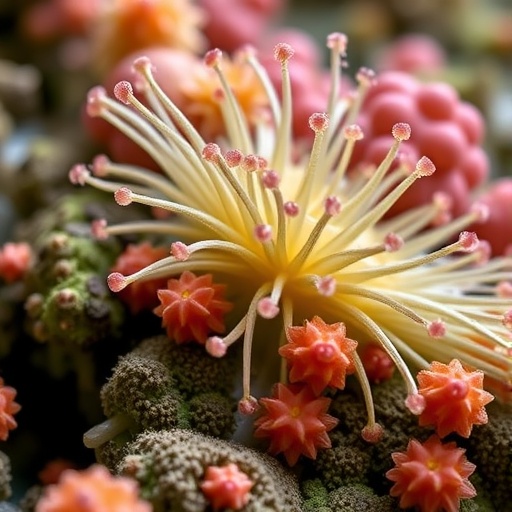In a remarkable new study, researchers have isolated a potent biosurfactant-producing bacterial endophyte from the root galls of the lady’s finger plant, known scientifically as Abelmoschus esculentus. This significant discovery could have profound implications for various industries, including agriculture, biotechnology, and environmental remediation. The research showcases the intricate relationships between plants and beneficial microbes, emphasizing the role of endophytes in improving plant health and productivity.
Biosurfactants are naturally occurring surface-active agents produced by microorganisms. They have the ability to reduce surface tension between liquids and can emulsify various compounds, making them invaluable in diverse applications ranging from bioremediation to pharmaceuticals. This study shines a light on how endophytes, which live within plant tissues without causing harm, can produce these vital compounds, opening new avenues for sustainable practices.
The investigation was conducted by a team led by researchers Malakar and Deka, who meticulously sampled plant tissues from lady’s finger plants affected by galls. These galls, often a result of insect activity or pathogen infection, provided an enriching environment for microbial communities. By cultivating these unique bacterial strains in the laboratory, the researchers were able to identify and characterize an endophyte capable of producing a high yield of biosurfactants.
The potential of the identified bacterial endophyte is not just theoretical; the researchers conducted rigorous tests to quantify the biosurfactant production. They employed a variety of analytical techniques, including surface tension measurements and emulsification index assessments, to evaluate the effectiveness of the biosurfactants. The results indicated a significant reduction in surface tension, which is a promising indicator of their utility in practical applications.
Further studies highlighted the biochemical nature of the biosurfactants produced by this endophyte. The research team performed chemical analyses using gas chromatography-mass spectrometry (GC-MS) to determine the structural composition of the biosurfactants. This allowed them to identify specific fatty acids responsible for the surface-active properties. Understanding the molecular makeup of these compounds is crucial for leveraging their applications across different fields.
One of the major highlights of this research is the environmental implications of using biosurfactants. Unlike synthetic surfactants, which often pose environmental hazards and can be toxic to aquatic life, biosurfactants are biodegradable and less harmful. This makes them suitable for applications in bioremediation, where they can be employed to clean up oil spills and heavy metal contamination in soil and water.
Moreover, the agricultural sector stands to benefit immensely from this discovery. Biosurfactants have been shown to enhance plant growth by improving nutrient uptake and reducing diseases caused by soil pathogens. The endophyte isolated from lady’s finger can potentially be used as a biofertilizer or a biopesticide, contributing to sustainable agriculture practices that are essential for feeding a growing global population.
The study’s findings also suggest a deeper understanding of plant-microbe interactions. The presence of this biosurfactant-producing endophyte in root galls indicates a complex relationship where the endophyte could be protecting the plant from pests or diseases. This reciprocal relationship not only enhances the health of the lady’s finger plant but could also inform strategies for cultivating other crops in challenging environments.
As the research progresses, the authors express excitement about the future applications of their findings. They envision a range of products derived from this bacterial endophyte that could be utilized not only in agriculture but also in the cosmetic and pharmaceutical industries. Biosurfactants have applications in formulations that require gentle cleansing agents, opening a window to innovative product development.
Importantly, the researchers are already exploring the feasibility of scaling up the production of biosurfactants in economic and environmentally sustainable ways. By optimizing fermentation conditions in bioreactors, they aim to produce larger quantities of this valuable compound while minimizing costs. This could lead to commercially viable products made from naturally occurring materials, aligning with global shifts towards green chemistry.
Ultimately, this pivotal study exemplifies the untapped potential of microbial diversity in agriculture and environmental science. By harnessing the capabilities of beneficial endophytes like the one discovered in the lady’s finger plant, scientists are paving the way for sustainable solutions to some of the most pressing challenges faced by humanity.
As this research continues to unfold, it prompts a broader conversation about the importance of conserving biodiversity. Every unique microbial strain could hold the key to solutions in climate resilience, food security, and ecological restoration. Hence, the implications of this study stretch far beyond its immediate findings, inviting further research and exploration into the world of endophytes and their remarkable contributions.
Stay tuned as this groundbreaking research is set to be published in International Microbiology, promising to ignite discussions in academic circles and beyond. The potential applications that arise from biosurfactant-producing bacteria could dramatically shift paradigms in how we approach sustainability and innovation across various fields.
In conclusion, the isolation of a potent biosurfactant-producing bacterial endophyte from Abelmoschus esculentus marks a significant milestone in microbiological research. It not only expands our understanding of plant-microbe symbiosis but also paves the way for innovative solutions to modern challenges in agriculture and environmental management. The unfolding narrative of this discovery is one that many in the scientific community will be eager to follow, as future studies advance the dialogue on the significance of beneficial microbes in our ecosystems.
Subject of Research: Isolation of a potent biosurfactant-producing bacterial endophyte from the root galls of Abelmoschus esculentus.
Article Title: A potent biosurfactant producing bacterial endophyte isolated from root gall of lady’s finger (Abelmoschus esculentus).
Article References:
Malakar, C., Deka, S. A potent biosurfactant producing bacterial endophyte isolated from root gall of lady’s finger (Abelmoschus esculentus).
Int Microbiol (2025). https://doi.org/10.1007/s10123-025-00751-7
Image Credits: AI Generated
DOI: 10.1007/s10123-025-00751-7
Keywords: biosurfactants, endophytes, Abelmoschus esculentus, sustainable agriculture, environmental remediation, microbial diversity.




